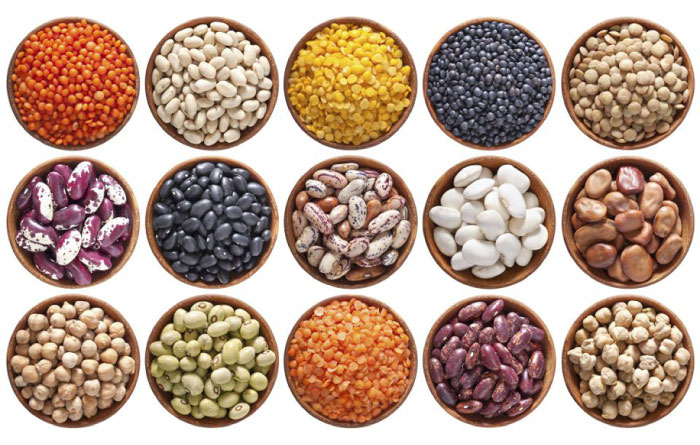International Year of Pulses: How Soybeans are Part of the Mix

By Ron Friesen
When it comes to soybeans, Denis Cloutier is a bit different from most contracting agents. He markets them for food, not feed.
Cloutier is the Western Canadian agent for SunOpta Grains and Foods Inc., a Canadian company with an office in Moorhead, Minnesota. He contracts food-grade, non-genetically modified (GM) soybeans from local growers, which SunOpta buys for the food market. The soybeans are shipped to Moorhead for conditioning and then sold mainly to Asia for processing into tofu, miso, soymilk, and other soybean-based products.
Although a staple food in parts of Asia and other countries, soybeans make up a very small part of the human diet in North America. But Cloutier, who contracts three percent of the soybean acreage in Manitoba, says that’s starting to change, especially among non-GM aficionados.
“It’s not growing exponentially but it is definitely growing and there’s becoming much more awareness by people wanting to buy non-GM just about everything,” he says.
Cloutier is among a small but select number of industry officials who want people to eat soybeans themselves instead of just feeding them to livestock. Now, a worldwide event being celebrated this year might help.
The United Nations General Assembly has declared 2016 as the International Year of Pulses (IYP). The purpose of the event is to raise the public profile and encourage consumption of pulse crops such as lentils, dry beans and peas, and chickpeas. It’s hoped that soybeans, although technically not a pulse crop, may still ride to success on the coattails of their cousins.
“I think IYP will shine a very bright spotlight for consumers and food companies on the increased role pulses can play in dealing with some of society’s chronic diet-related diseases like heart disease and diabetes,” says Carl Potts, executive director of Saskatchewan Pulse Growers. “Consumers are looking for high-protein, low glycemic index foods. Soybeans are certainly a good source of protein, so they fit a lot of those attributes.”
That’s an important consideration for budget-conscious shoppers who want to include protein in their diets but are turned off by the sky-high price of beef in supermarkets these days, Potts adds.
“Food companies and consumers are looking to plant-sources of protein as alternatives or supplements to meat.”
According to Manitoba Pulse and Soybean Growers, pulses are edible seeds of legumes (plants with a pod). Pulse comes the Latin word puls, meaning “thick soup.” Pulses are considered very nutritious and contain high sources of fibre, folate, iron, and complex carbohydrates. They are also low in fat.
Strictly speaking, soybeans are not pulses because the seeds are not dry. Instead, they contain high amounts of oil. As a result, soybeans are treated primarily as an oilseed. In North America, most soybeans are crushed and the meal is used for livestock feed, with the oil as a byproduct.
But MPSG notes that soybean oil is used extensively in processed foods such as salad dressings, margarine and shortening. That makes you a soybean eater whether you realize it or not.
Soybeans and pulses have agronomic similarities, too. Dennis Lange, an industry development pulse specialist for Manitoba Agriculture, Food and Rural Development, points out that both are legumes, which fix their own nitrogen from the atmosphere. This makes them low-input crops because it reduces the need for nitrogen fertilizer. Because soybeans and pulses fix their own nitrogen, they leave some residual N in the soil for the following crop. Both are long-season crops and benefit from warm weather and timely rains to fill seedpods.
There are other agronomic advantages, too. According to Pulse Canada, introducing nitrogen-fixing crops to crop rotations can improve the yield and quality of wheat. Adding legumes to rotations can also break up weed and disease cycles, as well as having a positive effect on soil and water. This gives growers less incentive to push their rotations and risk herbicide resistance through the continuous use of similar products. Altogether, including pulses and soybeans in the rotation can play an important role in sustainable agriculture.
“At the end of the day, whether it be a pulse or a soybean, both add to the rotation in terms of breaking up disease cycles. You’re also looking at different herbicide chemistries,” Lange says.
A benefit for producers of growing soybeans for the food market is price. Cloutier, who owns DNS Commodities in Winnipeg, says food-grade soybeans can fetch a premium of $2 a bushel, depending on the year.
Of course, there are protocols to follow. Cloutier says growers must start off with clean fields which haven’t had Roundup Ready soybeans on them for at least two years. Fields must be inspected and bins checked and sampled. Machinery must be cleaned to guard against cross-contamination. Essentially, non-GM soybeans for the food market are grown under an identity preserved (IP) system.
Lange admits IYP alone may not increase soybean acres in Western Canada. Even so, there are reasons to believe that edible soybean consumption will grow. Throughout the world, soybeans are a more genetically developed crop than pulses. As a result, their demand for meal, oil, and food is well established. Ontario growers have been supplying Europe and Japan with food-grade soybeans for years, taking advantage of their proximity to ocean ports.
In the end, IYP hopes to create opportunities for more global production of pulses and better use of pulse-based proteins. And people like Lange are big cheerleaders.
“Eat more pulses,” he encourages people. “Always try to incorporate pulses into the diet for various reasons. I think the International Year of Pulses will bring more awareness of what a pulse crop is and what the benefits are. If we can incorporate a few more pulses into the diet, that will hopefully make us healthier people.”
That goes for soybeans, too.


